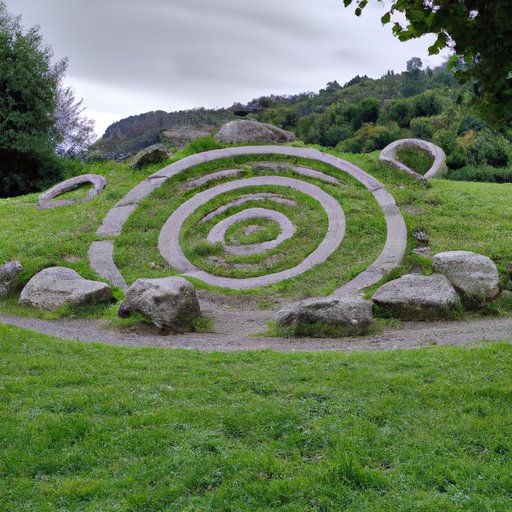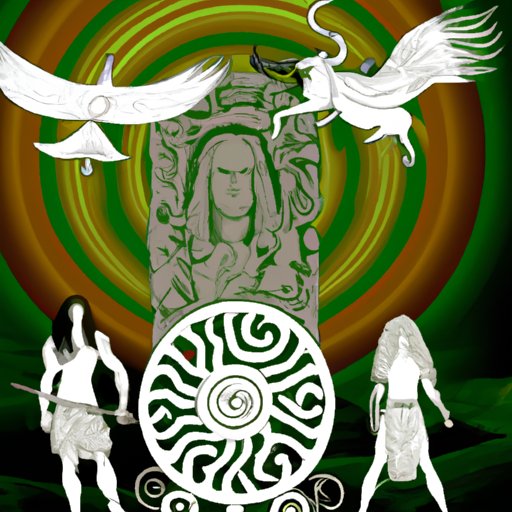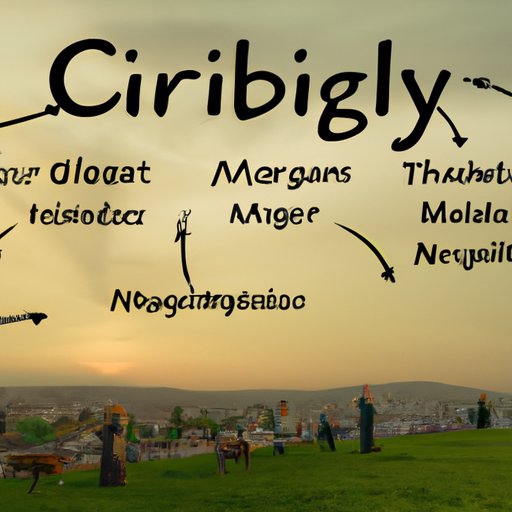Introduction
Celtic culture is a term used to describe the shared identity of the various tribes and peoples who inhabited Europe prior to the Roman Empire. The Celts were renowned for their craftsmanship, artistry, and spirituality, and their impact can still be felt in many aspects of modern life. In this article, we will explore the history, symbols, beliefs, art, music, literature, and mythology associated with Celtic culture, as well as examining its impact on the world today.

A Historical Overview of Celtic Culture
The Celts were an ancient people who lived in Central and Western Europe from around 1200 BC to 100 AD. During this period, they established settlements across the continent, from Spain to the British Isles. They were known for their skill in battle and their innovative use of iron weapons and tools.
The origin of the Celts is disputed, with some historians believing they originated in Central Europe while others believe they came from the eastern Mediterranean. Whatever their origin, they quickly spread throughout Europe, establishing settlements in what is now France, Germany, Austria, Switzerland, and the British Isles. As they moved, they interacted with other cultures, creating a unique blend of beliefs and practices.
By the fourth century BC, the Celts had become one of the most powerful forces in Europe. They engaged in frequent wars with other tribes, such as the Romans and Greeks, and developed a reputation as fierce warriors. Despite their military prowess, they were also skilled craftsmen and artists, producing intricate jewelry, metalwork, and pottery.
The decline of the Celts began in the first century BC, when Julius Caesar invaded Gaul (modern-day France). The Celts were eventually defeated by the Romans, but their influence continued to spread throughout Europe. Even after their defeat, the Celts maintained their language, religion, and culture in the areas they settled.
Exploring the Symbols and Beliefs of Celtic Culture
Celtic culture is rich in symbolism, which has been used to convey spiritual and cultural messages for centuries. These symbols are still found in modern art, jewelry, and tattoos, expressing a connection to the past.
Animal symbolism was particularly important to the Celts. Animals represented different aspects of nature and spirit, as well as qualities such as strength, speed, and cunning. Common animal symbols include horses, wolves, deer, and eagles.
Knotwork designs were also an important part of Celtic art. These intricate patterns were used to decorate objects such as jewelry, weapons, and clothing. They were believed to symbolize eternity, unity, and interconnectedness.
The Celts also had a strong belief in the power of the supernatural. They worshipped a variety of gods and goddesses, as well as animistic spirits that inhabited the natural world. Their mythology is filled with tales of heroes, monsters, and magical creatures.
Examining the Art, Music, and Literature of Celtic Culture
Celtic culture has long been celebrated for its artistic expressions, which range from visual arts to music and literature. Visual arts such as painting and sculpture were used to depict scenes from mythology and everyday life. Metalworking was also popular, with Celts producing intricate jewelry, weapons, and tools.
Music was an integral part of Celtic culture, with instruments such as harps, pipes, and drums being used to create a unique sound. This music has endured, with many modern musicians incorporating traditional Celtic sounds into their own work.
Literature was also important to the Celts. They produced epic poems and sagas, which recounted the deeds of heroes and gods. These stories were passed down orally, giving us insight into the beliefs and values of the Celts.

Investigating the Role of Mythology in Celtic Culture
Mythology played an important role in Celtic culture. It provided explanations for natural phenomena and served as a source of moral guidance. Many of the stories revolved around nature deities, such as the sun god Belenus, the earth goddess Danu, and the sea god Manannan.
Human deities were also important. The Celts believed in a pantheon of gods, such as Lug, the god of light and truth, and Brigid, the goddess of fertility and healing. These gods were believed to have the power to shape human destiny.
Legends and folklore were also an important part of Celtic mythology. These stories often featured magical creatures, such as dragons, giants, and fairies, and were used to explain the mysteries of the natural world.

Analyzing the Impact of Celtic Culture on Modern Society
Celtic culture has had a lasting impact on modern society. Celtic symbols, such as the triskelion and the shamrock, have become popular emblems, appearing on everything from jewelry to flags. Celtic music has also gained popularity, with many modern bands incorporating traditional sounds into their work.
In recent years, there has been a renewed focus on preserving and celebrating Celtic culture. Organizations such as the Celtic League and the Order of Druids have worked to promote Celtic languages, traditions, and beliefs. There has also been an increase in festivals, such as the Pan Celtic Festival in Ireland, which celebrates Celtic culture through music, dance, and storytelling.
Conclusion
Celtic culture is an ancient and varied tradition, with roots stretching back centuries. Its influence can still be seen in many aspects of modern life, from art to music and literature. From its origins to its symbols, beliefs, and impact on the world today, Celtic culture remains a vibrant and influential force.
Summary of Key Points
This article explored the history, symbols, beliefs, art, music, literature, and mythology of Celtic culture. We looked at its origins, expansion, and decline, as well as its animal symbolism, knotwork designs, mythology, and impact on modern society. Finally, we discussed the importance of preserving and celebrating Celtic culture in the present day.
Final Thoughts
Celtic culture is a unique and fascinating tradition. Its symbols, beliefs, and art are a testament to its resilience and longevity, and its impact on the world today is undeniable. Whether you are drawn to its mystical beauty or simply appreciate its cultural richness, exploring Celtic culture is sure to be an enriching experience.
(Note: Is this article not meeting your expectations? Do you have knowledge or insights to share? Unlock new opportunities and expand your reach by joining our authors team. Click Registration to join us and share your expertise with our readers.)
